SIEMENS RDE100.1DHW Room Thermostat
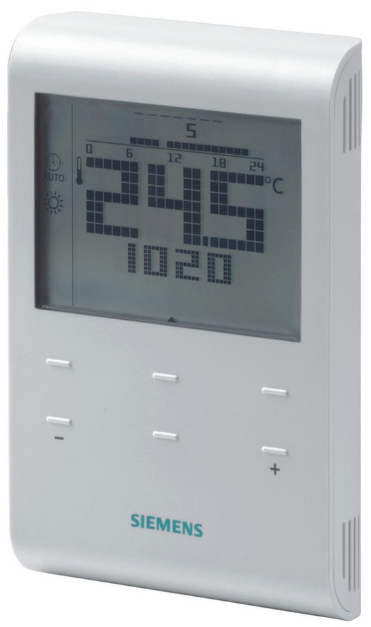
FEATURES
- Room temperature control
- 2-position / TPI control with On/Off output for heating
- Optimum Start / Stop
- Comfort, Economy, Auto timer and Protection mode
- Independent On/Auto/Off control of DHW
- Auto time switch
- Adjustable commissioning and control parameters
- Battery-powered DC 3 V (2 x 1.5 V AAA)
Use
The RDE100.1DHW is used to control the room temperature in heating systems with independent control of DHW.
Typical applications:
- Residential apartments
For the control of the following plant components and of DHW:
- Thermal valves or zone valves
- Gas or oil boilers
- Fans
- Pumps
- Heat exchanger
- Continuous-flow water heater
- Small water heating systems
Functions
- Room temperature control via built-in sensor
- Selection of operating mode with operating mode touchkey
- Setting auto time switch (individual day, 7 day or 5-2 day)
- Display of current room temperature or setpoint in °C or °F
- Touchkey lock (manually)
- Setpoint lock
- Periodic pump run
- Optimum start / stop
- Comfort temperature limitation by Economy setpoint locked
- Reloading factory settings for commissioning and control parameters
- Independent DHW and its auto time switch (individual day, 7 day or 5-2 day)
Temperature control
RDE100.. comprises of both 2-position and TPI temperature controls, which can be configured by parameter P78 (Control Behavior). 2-position control algorithm is to switch on and off the heating system within a switching differential according to comparison between setpoint setting and the measured room temperature.
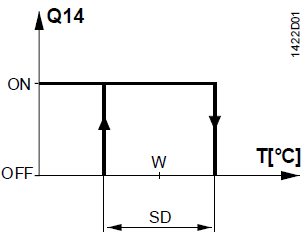
- T: Room temperature
- SD: Switching differential
- W: Room temperature setpoint
- Q14: Output signal for heating
TPI (Time proportional Integral) control algorithm is to periodically switch on and off the heating system. The period time and pulse length of the control signal (PWM) are determined by the setpoint and the measured room temperature.
Heating mode
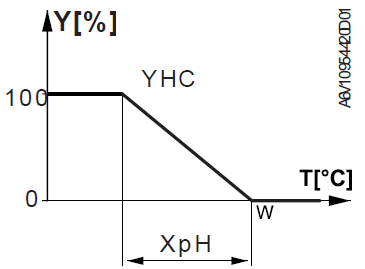
- T: Room temperature
- Y: Output signal for heating (PWM)
- W: Room temperature setpoint
- YHC: Control command “Valve”
- XpH: Proportional band “Heating”
Periodic pump run function
Can only be used when circulating pump or valve is controlled! This function protects the pump or valve against seizing during longer off periods. Perodic pump run is activated for 3 minutes every 24 hours at 12:00.
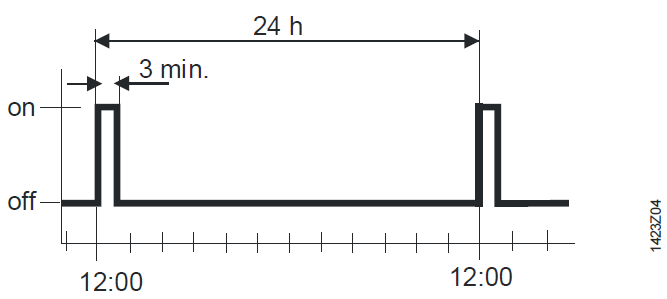
| Parameter | Pump status |
| P12 = 0 (Default) | Pump run off |
| P12 = 1 | Pump run on |
Optimum start control
The purpose of optimum start control is to reach a temperature level 0.25 K below the Comfort setpoint when occupancy according to the time program starts in Auto timer mode. For that purpose, the heating circuit must be switched on at an earlier point in time. The extent of forward shift depends primarily on the outside temperature. The maximum forward shift on time can be adjusted by parameter P89. A Forward shift on maximum “0” means the function is disabled.
| Parameter | Range | Factory setting |
| Forward shift on max (P89) | 0, 0.5,…24 h | 0 |
Optimum stop control
Optimum stop control switches off the heating circuit at the earliest possible point in time so that the room temperature will lay 0.5 K below the Comfort setpoint when the time switch changes from Comfort mode to the Economy mode in Auto timer mode. The early shut down maximum time can be adjusted by parameter P90. Early shut down maximum “0” means the function is disabled.
| Parameter | Range | Factory setting |
| Early shutdown max (P90) | 0, 0.5,….6 h | 0 |
Control behavior (P78)
- 2-position, 1 K: 2-Position controller with 1 [K] switching hysteresis
- 2-position, 0.3 K: 2-Position controller with 0.3 [K] switching hysteresis.
- For general control situations. Provides a better comfort than 1 [K] switching hysteresis.
- Can also be used for difficult control situations.
TPI slow
TPI control behavior for slow heating systems that require longer minimum On times and limited numbers of switching cycles per hour. Typical applications:
- Floor heating systems, oil fired boilers
- Can also be used for all other types of heating applications. (Alternative setting)
| Minimum switching on / off time | > 4 minutes |
| Average period time | Approximately 20 minutes |
TPI medium
TPI control behavior for general heating applications such as radiator systems, thermal actuators, …
| Minimum switching on / off time | > 1 minute |
| Average period time | Approximately 20-25 minutes |
TPI fast
TPI control behavior for fast heating systems that tolerate a high number of switching cycles. Typical applications: electric heaters, gas boilers, fast thermal actuators.
| Minimum switching on / off time | > 1 minute |
| Average period time | Approximately 10 minutes |
 Do not use TPI fast for oil boilers or electro-mechanical actuators!
Do not use TPI fast for oil boilers or electro-mechanical actuators!
Type summary
| Product No. | Stock No. | Features |
| RDE100.1DHW | S55770-T280 | Battery-powered DC 3 V |
Ordering
- When ordering, please indicate product No. / stock No. and description.
- Example:
| Product No. | Stock No. | Description |
| RDE100.1DHW | S55770-T280 | DHW room thermostat |
- Valve actuators must be ordered separately!
Equipment combinations
|
Description |
Product No. |
Data Sheet *) |
Use with the type of Temperature Control | |
| Electromotoric actuator | 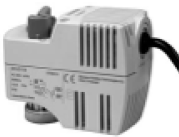 |
SFA21.. |
4863 |
2-Position & TPI slow |
| Electrothermal actuator (for radiator valves) |  |
STA23.. |
4884 |
2-Position & All TPI |
| Electrothermal actuator (for small valves 2.5 mm) | 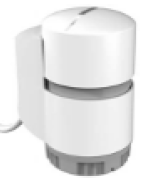 |
STP23.. |
4884 |
2-Position & All TPI |
| Electromotor actuator for zone valves VVI46.. | 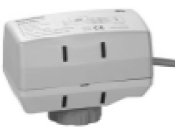 |
SUA21.. |
4830 |
2-Position |
|
Damper actuator |
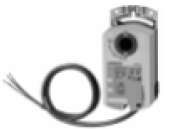 |
GDB.. |
4634 |
2-Position & TPI slow |
|
Damper actuator |
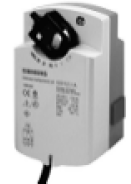 |
GSD.. |
4603 |
2-Position & TPI slow |
|
Damper actuator |
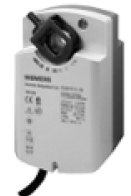 |
GQD.. |
4604 |
2-Position & TPI slow |
| Rotary damper actuator | 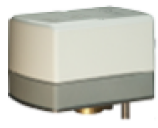 |
GXD.. |
4622 |
2-Position & TPI slow |
*) The documents can be downloaded from http://siemens.com/bt/download.
Mechanical design
The room thermostat consists of 2 parts:
- Plastic housing which accommodates the electronics, the operating elements and the room temperature sensor
- Mounting plate with screw terminals
The housing engages in the mounting plate and is secured with a screw.
Operation and settings
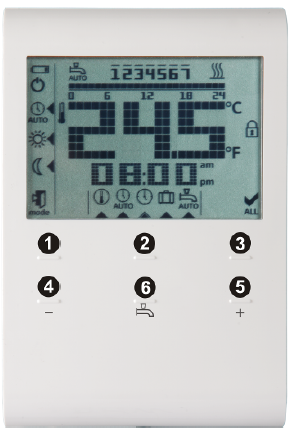
- Operating mode touchkey
- Set
- Ok
- Touch key for decreasing a value
- Touch key for increasing a value
- DHW switch On/Auto/Off touchkey
Display
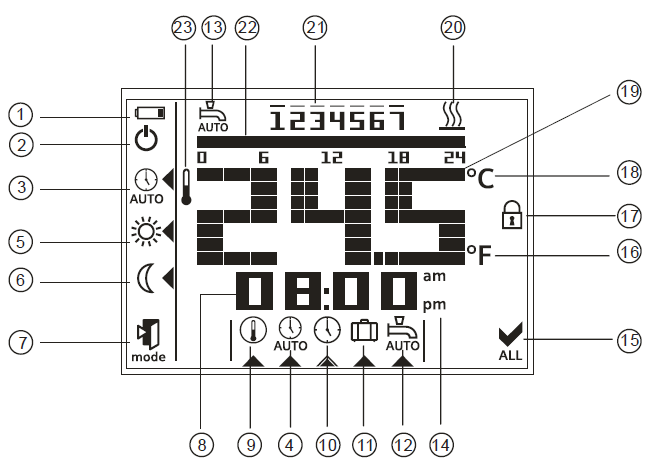
Symbol /Description
 Indicating that batteries need to be replaced
Indicating that batteries need to be replaced Protection mode
Protection mode
- (protection mode symbol can be enabled via parameter settings).
 Auto timer mode
Auto timer mode- View and set auto time switch
 Comfort mode
Comfort mode Economy mode
Economy mode Escape
Escape Display of time
Display of time Permanent setpoint setting
Permanent setpoint setting Day and time setting
Day and time setting Holiday mode setting
Holiday mode setting View and set DHW auto time switch
View and set DHW auto time switch- DHW auto time switch activated
 Morning: 12-hour format
Morning: 12-hour format
- Afternoon: 12-hour format
 Confirmation
Confirmation Room temperature in degrees Fahrenheit
Room temperature in degrees Fahrenheit Touch key lock activated
Touch key lock activated Room temperature in degrees Celsius
Room temperature in degrees Celsius Display of room temperature, setpoint, and etc.
Display of room temperature, setpoint, and etc. Heating On
Heating On Weekday 1 = Monday 7 = Sunday
Weekday 1 = Monday 7 = Sunday Timer bar (Alternative use as DHW timer bar)
Timer bar (Alternative use as DHW timer bar) Current room temperature
Current room temperature
Mounting and installation notes
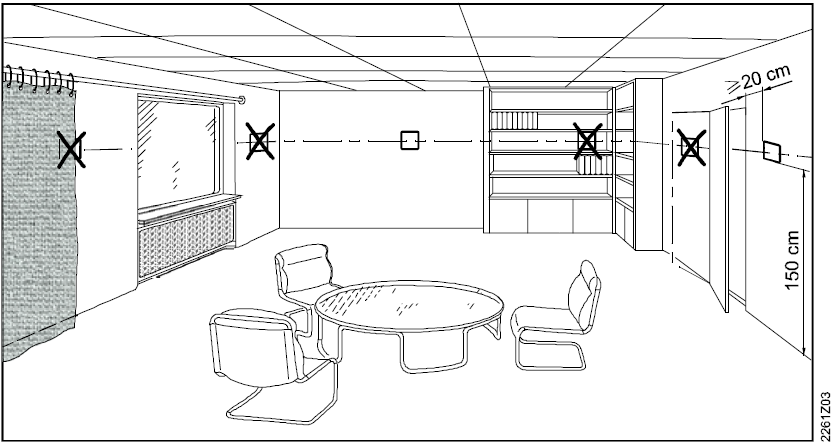
Do not mount the thermostat in niches or bookshelves, not behind curtains, not above or near heat sources, and not exposed to direct solar radiation. Mount about 1.5 m above the floor.
Mounting
- Mount the thermostat in a clean and dry location without direct airflow from a heating/cooling equipment, and not exposed to drip or splash water
Wiring
See the Mounting Instructions M1429 enclosed with the thermostat.
 Ensure that wiring, protection and earthing comply with local regulations
Ensure that wiring, protection and earthing comply with local regulations Correctly size the cables to the thermostat and the valve actuators
Correctly size the cables to the thermostat and the valve actuators Use only valve actuators rated for AC 24…230 V
Use only valve actuators rated for AC 24…230 V
![]() Warning
Warning
No internal line protection for supply lines to external consumers.
Risk of fire and injury due to short-circuits!
 Adapt the line diameters as per local regulations to the rated value of the installed overcurrent protection device.
Adapt the line diameters as per local regulations to the rated value of the installed overcurrent protection device. The AC 230 V mains supply line must have a circuit breaker with a rated current of no more than 10 A
The AC 230 V mains supply line must have a circuit breaker with a rated current of no more than 10 A Disconnect from power supply before removing the unit from its mounting plate.
Disconnect from power supply before removing the unit from its mounting plate.
Commissioning notes
Commissioning
After power is applied, the thermostat carries out a reset during which all LCD segments flash, indicating that the reset was made correctly. After the reset, the thermostat is ready for commissioning by qualified HVAC personnel. The control parameters of the thermostat can be set to ensure optimum performance of the entire system. Please refer to Operating Instructions CB1B1423, section “Do you want to change parameters?”.
Sensor calibration
If the temperature on the display does not agree with the room temperature effectively measured, the temperature sensor can be recalibrated. For that purpose, adjust parameter P04.
Setpoint lock
We recommend reviewing the setpoint lock (for public areas) in parameters P06 and P08 and changing them as needed. If the Economy setpoint is locked then the Comfort temperature setpoint can not be set lower than the locked Economy setpoint.
Touchpad scanning rate
Since the thermostat uses touch technology and to minimize battery power consumption, a parameter P21 (adjustable from 0.25 to 1.5 seconds) is implemented for the user to adjust. This function is only valid for the battery-powered version and the default value is 1 second.
This means that when, for a certain time, the user does not touch the touchpad, the unit operates in power saving mode and the touchpad is running at a scanning rate of 1 second. (From the calculation – assuming 4 operations per day on the thermostat, the estimated 1-second scanning rate results in a battery life of 1 year. If the user increases the scanning rate, the battery’s life is extended.)
Change of batteries
If the battery symbol ![]() appears, the batteries are almost exhausted and should be replaced. Use alkaline batteries type AAA.
appears, the batteries are almost exhausted and should be replaced. Use alkaline batteries type AAA.
Operating notes
The RDE100.1DHW provides Comfort, Economy, Auto timer and Protection mode. The difference between Comfort and Economy mode is only the room temperature setpoint. The changeover between Comfort, Economy and Protection mode is made either automatically by the auto time switch or by pressing touch key mode.
Comfort mode![]()
- When Comfort mode is activated, symbol
 appears on the display. The setpoint (20 ºC) can be readjusted by pressing touch keys + and –.
appears on the display. The setpoint (20 ºC) can be readjusted by pressing touch keys + and –.
Economy mode![]()
- When Economy mode is activated, symbol
 appears on the display. The setpoint (16 ºC) can be readjusted by pressing touch keys + and –.
appears on the display. The setpoint (16 ºC) can be readjusted by pressing touch keys + and –.
Protection mode![]()
- If the temperature falls below 5 ºC, the unit automatically activates the heating output. The symbol
 appears only, if the icon is enabled via parameter settings.
appears only, if the icon is enabled via parameter settings.
Holiday mode![]()
- When holiday mode is activated, the symbol
 appears on the display. The setpoint (12 ºC) and the number of days a user is away can be readjusted by pressing touch keys + and –.
appears on the display. The setpoint (12 ºC) and the number of days a user is away can be readjusted by pressing touch keys + and –.
Time switch![]()
When Auto timer mode is enabled, the changeover between the operating modes (Comfort and Economy mode) will take place automatically. There are three options for time switch setting: individual day, 7 day or 5-2 day. You can select Comfort or Economy mode in every 15 minutes interval of the day. The 0:00 to 24:00 hour time bar will allow you to set the mode throughout the selected day(s).
Factory default for 7-day Time switch
| Default value | Day/s | Comfort mode | Economy mode |
| Mo (1) – Fr (5) | 6:00 – 8:00 hr
17:00 – 22:00 hr |
22:00 – 6:00 hr
8:00 – 17:00 hr |
|
| Sa (6) – Su (7) | 7:00 – 22:00 hr | 22:00 – 7:00 hr |
Please refer to Operating Instructions CB1B1423, section “Do you want to enter your own Time switch?”.
DHW![]() and DHW auto timer function
and DHW auto timer function![]()
Press![]() to switch on DHW heating. Press this
to switch on DHW heating. Press this![]() touch key again, DHW will be in the auto status, this AUTO symbol
touch key again, DHW will be in the auto status, this AUTO symbol![]() will be shown. Press this
will be shown. Press this![]() touch key one more time, DHW heating will be switched off and no symbol will be shown. Please refer to Operating Instructions CB1B1423, section “Do you want to activate DHW control?”. During auto status, the DHW will switch according to the DHW time switch set. DHW can be selected on or off in every 15 minutes interval of the day. The 0:00 to 24:00 hour time bar will allow you to set DHW on or off throughout the selected day(s).
touch key one more time, DHW heating will be switched off and no symbol will be shown. Please refer to Operating Instructions CB1B1423, section “Do you want to activate DHW control?”. During auto status, the DHW will switch according to the DHW time switch set. DHW can be selected on or off in every 15 minutes interval of the day. The 0:00 to 24:00 hour time bar will allow you to set DHW on or off throughout the selected day(s).
Factory default for 7-day Time switch for DHW
| Default value | Day/s | DHW control ON | DHW control OFF |
| Mo (1) – Fr (5) | 6:00 – 8:00 hr
17:00 – 22:00 hr |
22:00 – 6:00 hr
8:00 – 17:00 hr |
|
| Sa (6) – Su (7) | 7:00 – 22:00 hr | 22:00 – 7:00 hr |
Please refer to Operating Instructions CB1B1423, section “Do you want to enter your own Time switch for DHW control?”.
Parameters
Changing the parameters by the following steps:
- Press + and – simultaneously for 5 seconds
- Release them and parameter “P01” is displayed on the bottom segment
- Press + or – to scroll to the parameter that needs to be adjusted
- Press ok to select this parameter
- Press + or – to adjust the value
- Press ok to confirm the adjusted value
- Press mode to exit the parameters without saving or wait for the program to exit automatically
Parameter list
| Parameter no. | Description | Setting range (default) |
| P01 | Time format | 1 = 24:00 hours (default)
2 = 12:00 AM/PM |
| P02 | Selection of °C or °F | 1 = °C (default) 2 = °F |
| P03 | Standard temperature display | 1 = room temperature (default)
2 = setpoint |
| P04 | Temperature sensor calibration | -3…3 °C
Step 0.5 °C (-6…6 °F, step 1 °F) Default: 0 °C |
| P06 | Comfort setpoint lock | 0 = OFF (default) 1 = ON è locked
according to setting in permanent temperature setpoint |
| P08 | Economy setpoint lock | 0 = OFF (default) 1 = ON è locked
according to setting in permanent temperature setpoint |
| P09 | Buzzer | 0 = OFF
1 = ON (default) |
| P10 | Show frost protection icon | 0 = OFF (default) 1 = ON |
| P11 | Time switch type for auto timer and DHW | 0 = Individual Days (default)
1 = All 7 days 2 = 5/2 days |
| P12 | Periodic pump run | 0 = OFF (default) 1 = ON |
| P13 | DHW timer bar timeout | 0 = no DHW bar
1 = 1 minute (default) 2 = 2 minutes Adjustable range 0 to 15 minutes |
| P21 | Button scanning rate for the capacitive buttons
Note: a higher scanning rate means shorter battery life. |
0.2 = 0.25 s
0.5 = 0.5 s 1.0 = 1.0 s (default) 1.5 = 1.5 s |
| P22 | Reload factory settings | 0 = OFF (default)
1 = reload |
| P23 | Software version information | No adjustment possible |
| P78 | Control behavior | 0 = On/Off, 1.0 K
1 = On/Off, 0.3 K 2 = TPI fast 3 = TPI medium 4 = TPI slow (default) |
| P89 | Forward shift on max | 0, 0.5,…24 h
Default: 0 h |
| P90 | Early shutdown max | 0, 0.5,…6 h
Default: 0 h |
Maintenance notes
- The thermostats are maintenance-free.
 Disposal
Disposal
The device is considered an electronic device for disposal in terms of the European Directive 2012/19/EU and may not be disposed of as domestic garbage.
- Dispose of the device through channels provided for this purpose.
- Comply with all local and currently applicable laws and regulations.
- Dispose of empty batteries in designated collection points.
 |
WARNING | |
Risk of explosion due to fire or short-circuit, even if the batteries are empty Risk of injuries from by flying parts
|
||
 |
WARNING | |
| Electrolyte leakage Chemical burns
• Only grasp damaged batteries using suitable protective gloves. • If electrolyte comes into contact with eyes, immediately rinse eyes with plenty of water. Consult a doctor. |
||
Observe the following:
- Only replace batteries with batteries of the same type and from the same manufacturer.
- Observe the polarities (+/-).
- The batteries must be new and free from damage.
- Do not mixed new batteries with used batteries.
- Store, transport, and dispose of the batteries in accordance with local regulations, guidelines, and laws. Also observe information from the battery manufacturer.
Technical data
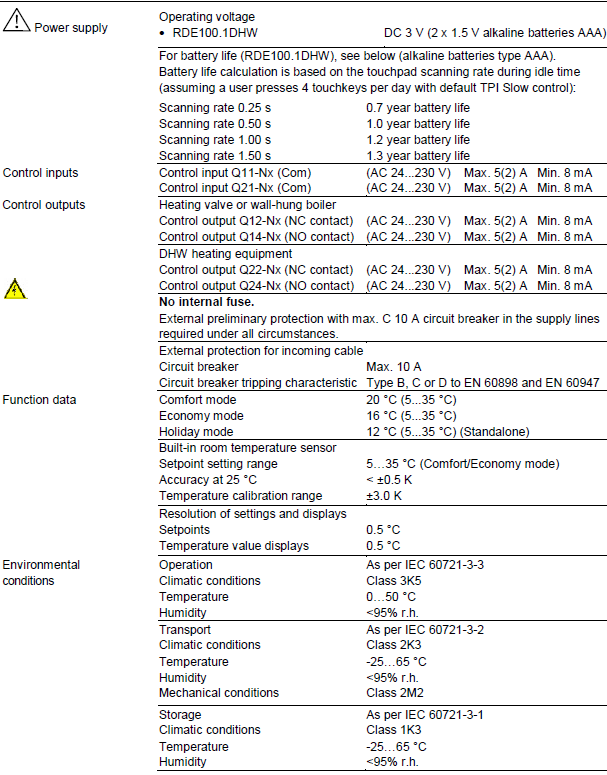
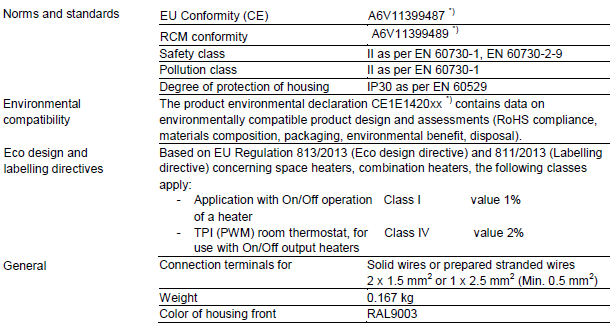
*) The documents can be downloaded from http://siemens.com/bt/download.
Connection diagrams
Legend
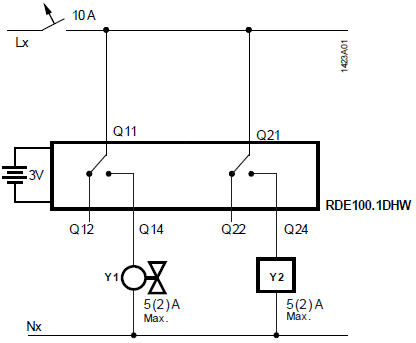
- Lx: Live, AC 24…230 V
- Nx: Neutral conductor, AC 24…230 V
- Y1: Heating valve or wall-hung boiler
- Y2: DHW heating equipment
Application examples
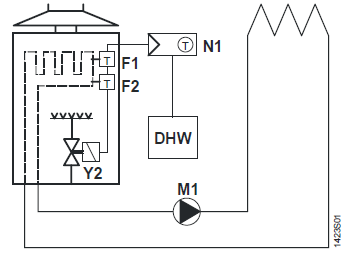
- Room thermostat with direct control of a gas-fired wall-hung boiler and independent control of DHW.
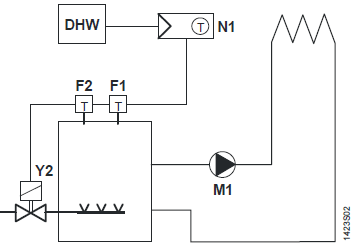
- Room thermostat with direct control of a gas-fired floor-standing boiler and independent control of DHW.
Legend
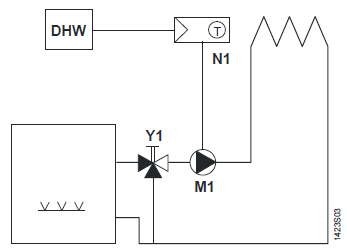
- F1: Thermal reset limit thermostat
- F2: Safety limit thermostat
- M1: Circulating pump
- N1: RDE100.1DHW room thermostat
- Y1: Mixing 3-port valve with manual
- Y2: adjustment
- DHW: Magnetic valve
- DHW heating equipment
Room thermostat with direct control of a heating circuit pump (precontrol by manual mixing valve) and independent control of DHW.
Dimensions
All dimensions in mm
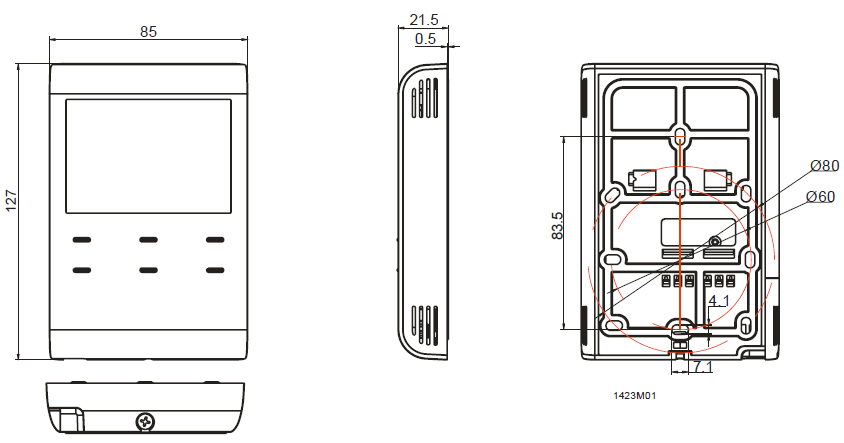
Remarks
Heating: Because of the unavoidable self heating effects of the electrical current, any loads of more than 3 Amperes connected to the unit can influence the control behavior and temperature accuracy in a negative way.
Issued by
- Siemens Switzerland Ltd
- Building Technologies Division
- International Headquarters
- Theilerstrasse 1a CH-6300 Zug
- Tel. +41 58 724 2424
- www.siemens.com/buildingtechnologies
© Siemens Switzerland Ltd., 2017
Technical specifications and availability are subject to change without notice.
RDE100.1DHW Room thermostat with Auto Timer, independent DHW
REFERENCE:
DOWNLOAD MANUALS:
SIEMENS RDE100.1DHW Room Thermostat Product Specifications Guide
OTHER MANUALS:
SIEMENS RDE100.1DHW Room thermostat Operating Manual
![]()
SIEMENS RDE100.1DHW Room Thermostat Product Specifications Guide

Leave a Reply